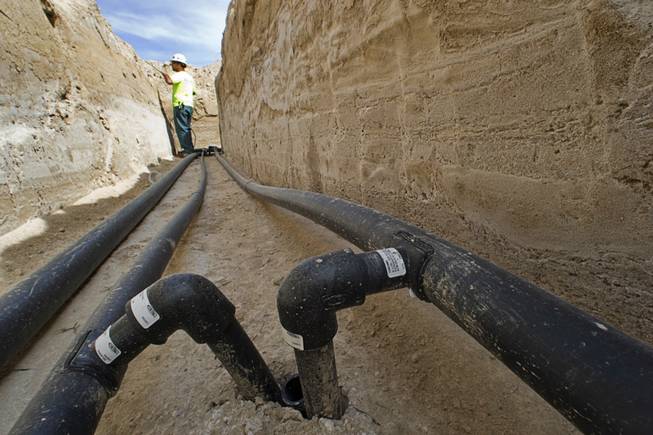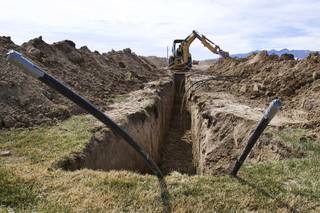
A circuit linking a series of vertical boreholes is shown at the site of a geothermal heat pump system near Pahrump Valley High School in Pahrump on Wednesday, March 30, 2011. The system, with 300 395-feet-deep boreholes, is being installed under an athletic field.
Friday, April 8, 2011 | 2:01 a.m.
Pahrump
Sun archives
- BLM geothermal lease sale nets $500,000 in Nev. (3-25-2011)
- Nevada gaining in development of geothermal energy (8-14-2010)
- Feds snatch counties’ share of money from geothermal leases (7-21-2010)
- Geothermal energy loses a bit of its steam (5-31-2010)
- Harry Reid, John Ensign work to reclaim rurals’ geothermal revenue (3-9-2010)
- Senate amends bill to restore geothermal money to counties (3-9-2010)
- NV Energy plans renewable energy purchase from geothermal plant (2-11-2010)
- Financing lag holds up geothermal (10-1-2009)
- Neighbor's open door a boon to Nevada (9-23-2009)
- Nevada geothermal growth: Full steam ahead (4-17-2009)
- Location of geothermal plant in BC gets planners' OK (4-16-2009)
- Councilman urges city to consider geothermic power plants (3-24-2009)
- Steam seen as power's future (9-16-2007)
Geothermal energy is an obvious fit in Northern Nevada, a region teeming with underground reservoirs of 300-degree brine waiting to be harnessed as electricity. In some places, the scalding water bubbles to the surface unaided.
In dirt-dry Southern Nevada, geothermal energy seems like a stretch. There are few hidden hot water aquifers, few underground Jacuzzis to be tapped.
But geothermal energy is as viable in Southern Nevada as it is in Northern Nevada — belying the south’s reputation as a solar-only zone. The process just uses a different technology.
“The Las Vegas Valley is ideal for geothermal,” said Stuart Lyle, project manager for EnLink Geoenergy, a California geothermal contractor working on several Southern Nevada projects.
Geothermal projects outside Reno, Carson City and Ely use wells plunged miles underground to pump hot water stored near the Earth’s magma core. The water is converted to steam, which powers turbines to generate electricity.
In Southern Nevada, geothermal projects use wells drilled only a few hundred feet deep. Tubing in the wells connects to a heat pump that replaces a building’s heating and air-conditioning equipment. Engineers pump water into the system to facilitate heat transfers.
The system takes advantage of the fact that shallow ground remains at a constant temperature — around 68 degrees year round. In winter, the system absorbs heat from the ground and distributes it to the building through a conventional duct system. In summer, the system transfers heat from the building to the underground piping loop, where it is cooled by the Earth.
The Clark County School District installed geothermal systems to heat and cool three of its trade schools. The Las Vegas PBS building on East Flamingo Road has a similar system.
In Nye County, workers are boring into the ground to install geothermal systems that will heat and cool Manse Elementary and Pahrump Valley High schools. A third project is slated for Tonopah Elementary School.
The economic and environmental benefits of such projects have been studied by the Energy Department, which found they can lower energy bills up to 70 percent. The Environmental Protection Agency described geothermal heat pumps as “the most energy efficient, environmentally clean and cost effective space conditioning systems available.”
Although they are more expensive to install than traditional systems, savings are typically realized within two to five years of a project being completed. Savings come quicker in bigger buildings.
Consider that one unit of energy generated by a heating oil boiler costs an average of $49, while the same amount produced by a geothermal heat pump costs $6 to $8. The Nye County School District, for example, expects to save hundreds of thousands of dollars a year from the heat pump systems in Pahrump.
No transmission lines are needed, and the systems put no demand on the grid. The energy is also more reliable than solar or wind power because it’s not weather-dependent. And it produces no greenhouse gas emissions.
Because the technology uses no evaporative cooling systems, its water usage is nil. After an initial input of water is placed into the closed-loop system, no more is needed. EnLink estimates that each geothermal project in Nevada saves 1 million gallons of water a year.
The majority of equipment used in geothermal heat pump systems is hidden. Pipes and tubes are buried, mostly under parking lots, buildings or athletic fields, as is the case in Pahrump.
The low profile is perhaps the reason why so few Southern Nevadans are familiar with the technology.
“It’s invisible,” said Mark Mizrahi, EnLink’s president. “It’s hard to take people on a tour when it’s all underground. It’s less sexy to look at.”
Heat pump industry leaders admit they have a PR problem. “We understand people wonder: If it’s so great, why isn’t it used more?” Mizrahi said.
The answer is twofold.
First, the geothermal name can be misleading. As the Energy Department put it, the technology has a bit of an “identity crisis.”
People automatically hear geothermal and think of the deep mining in Northern Nevada. They figure geothermal energy can’t be used in Southern Nevada. In fact, geothermal simply means “Earth heat.”
Second, unlike solar and wind power, companies working on geothermal heat pumps have few strong advocates.
EnLink officials said they have never spoken with Senate Majority Leader Harry Reid, who has vowed to make Nevada the greenest state in the nation. Mizrahi asked, only half joking, if a reporter could facilitate a conversation.
In contrast, Reid has been a proponent of solar power in Southern Nevada and helped legislate incentives to make the projects more viable.
When asked about it, Reid seemed unfamiliar with the geothermal technology being used in Southern Nevada, although he mentioned he had heard of the project in Pahrump.
Heat pump technology is 70 years old (the science behind it is even older, as evidenced by the prehistoric use of caves as heat sinks and heat sources), and although the United States was once a leader in its development and use, Europe surpasses us in implementation almost three to one. Growth rates in China, South Korea and Canada also exceed those in the United States.
If more widely used, geothermal heat pumps could help ease Nevada’s reliance on the grid, lessen its water demand and save governments and homeowners money.
The Energy Department recently suggested that “federal policymakers seriously consider aggressively deploying geothermal heat pumps nationwide, with programs commencing as soon as possible, given the need to rein in our nation’s energy consumptions and carbon emissions, while at the same time stimulating our economy out of its most serious downturn since the Great Depression.”
The effort has started in Southern Nevada.


Join the Discussion:
Check this out for a full explanation of our conversion to the LiveFyre commenting system and instructions on how to sign up for an account.
Full comments policy